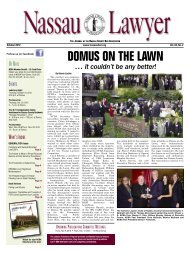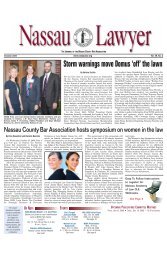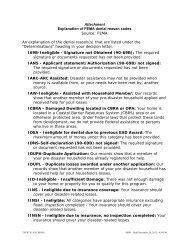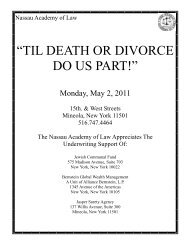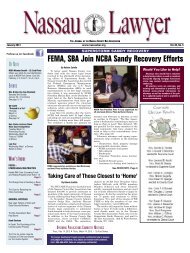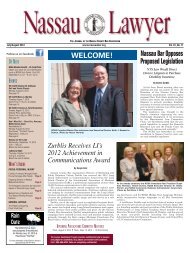302 B.R. 760 Page 10302 B.R. 760(Cite as: 302 B.R. 760)knowledge <strong>of</strong> the Spitzes' looting is not pr<strong>of</strong>itablyanalyzed in isolation from State Street's awareness <strong>of</strong>the Spitzes' accounting fraud.Actual Knowledge[7][8] At the outset, the Bankruptcy Court correctlyobserved that the complaint's extensive recitation <strong>of</strong>the circumstances that allegedly caused State Streetto suspect fraud at Sharp--including, inter alia,Sharp's failure to comply with the reporting requirementsset forth in its loan agreement, and the unmistakableparallels between Sharp's behavior and that <strong>of</strong>PT Imports--are not, standing alone, sufficient tomeet the actual knowledge standard <strong>of</strong> an aiding andabetting claim under New York law. See Bankr.Dec.at 514. Indeed, the case law suggests that assertionsthat an alleged aider and abettor harbored wellfounded--butunconfirmed--suspicions <strong>of</strong> the primaryviolator's wrongdoing are not sufficient to plead actualknowledge simply because, with the benefit <strong>of</strong>hindsight, those suspicions turned out to be correct.[9] In Ryan v. Hunton & Williams, 2000 WL1375265 (E.D.N.Y. Sept.20, 2000), for example, defraudedinvestors alleged that Chemical Bank aidedand abetted a "Ponzi" scheme carried out throughaccounts at the bank. The bank was "on notice <strong>of</strong>various 'red flags' that indicated fraudulent conduct."Id. at *1. Indeed, as soon as the accounts wereopened, the bank's branch <strong>of</strong>ficer "suspected that theywere a vehicle for fraudulent activity and immediatelyreferred them to Chemical's in-house fraud investigativeunit." Id. The fraud unit recommendedthat the accounts be closed immediately, and the accountswere shut down approximately a month later.See id. Prior to the closing <strong>of</strong> the accounts, however,bank <strong>of</strong>ficials "approved multiple wire transfers thatresulted in the theft <strong>of</strong> investor funds." Id. at *2. Thecourt dismissed the aiding and abetting claim, concluding,inter alia, that the plaintiffs failed to adequatelyplead *772 Chemical Bank's actual knowledge<strong>of</strong> the fraud. In this connection, the court notedthat "[a]llegations that [a defendant] suspectedfraudulent activity ... do not raise an inference <strong>of</strong> actualknowledge <strong>of</strong> [the] fraud." Id. at *9. See alsoRenner v. Chase Manhattan Bank, 2000 WL 781081,at *12 (S.D.N.Y. June 16, 2000) (granting 12(b)(6)motion to dismiss claim against a bank for aiding andabetting customer's prime bank guarantee scam, despitebank <strong>of</strong>ficials' suspicions <strong>of</strong> fraud--which ledthem to reject one <strong>of</strong> customer's proposed transactions--because the complaint alleged "no factual basisfor the assertion that Chase <strong>of</strong>ficials actually knewthe fraud [they suspected] was, in fact, occurring");Kolbeck v. LIT America, Inc., 939 F.Supp. 240(S.D.N.Y.1996) (finding that brokerage firm and associatedindividual defendants could not be "chargedwith knowledge" <strong>of</strong> the looting <strong>of</strong> investors' fundsdespite defendants' awareness <strong>of</strong> plaintiffs' accusations;"knowledge <strong>of</strong> accusations without more" didnot give rise to a duty to investigate, and did not supportan inference <strong>of</strong> actual knowledge <strong>of</strong> the fraud),In a case such as this, where an alleged aider andabetter in fact undertakes an investigation <strong>of</strong> the primarywrongdoer's conduct, determining the precisepoint at which evidence giving rise to suspicions <strong>of</strong>fraud reaches a cumulative critical mass sufficient tosupport an inference <strong>of</strong> actual knowledge is a factintensive inquiry not easily resolved on the face <strong>of</strong>the pleadings. Sharp's complaint identifies StateStreet's review <strong>of</strong> the D & B Reports on November18, 1998 as the moment when the bank's mountingsuspicions concerning accounting irregularities atSharp became actual knowledge <strong>of</strong> the Spitzes' fraud.See Compl. 47-48. As noted supra, these reportson 18 <strong>of</strong> Sharp's reported customers revealed that: 1)one <strong>of</strong> these customer had no known address; 2) anotherhad actually gone out <strong>of</strong> business in 1991; and3) "a number <strong>of</strong> others" did not appear to be in thewatch business at all--despite Sharp's reported salesto these entities <strong>of</strong> millions <strong>of</strong> dollars in watches.State Street argues that the information allegedlybefore it would have permitted inferences other thanthe presence <strong>of</strong> fraud at Sharp--e.g., that Sharp was afailing business, or had management that was incompetentor negligent--and therefore "cannot compel aninference that State Street knew <strong>of</strong> Sharp's fraud."State Street Mem. in Opp'n to Appeal ("State StreetMem.") at 10-11. Aside from the fact that what StateStreet is alleged to have known makes these alternativehypotheses highly unlikely, even assuming thatState Street could plausibly have reached such conclusions,the court is required, for purposes <strong>of</strong> thismotion to dismiss, to draw all reasonable inferencesin Sharp's favor. See Moy v. Adelphi Institute, Inc.,866 F.Supp. 696 (E.D.N.Y.1994) (citing Conley, 355U.S. at 45-46, 78 S.Ct. 99) ("Any uncertainty regardinginferences that may be drawn from a complaint'scontentions must be determined in the light most fa-© 2009 Thomson Reuters. No Claim to Orig. US Gov. Works.
302 B.R. 760 Page 11302 B.R. 760(Cite as: 302 B.R. 760)vorable to the plaintiff."). The test, therefore, is notwhether the facts alleged compel an inference favorableto Sharp, but rather whether they permit such aninference.Viewed in this light, Sharp's allegations are sufficientto plead State Street's actual knowledge <strong>of</strong> boththe false sales invoicing and probable looting by theSpitzes. State Street contends that the "limited information"revealed by the D & B Reports, concerning asubset <strong>of</strong> Sharp's customers, would not have led StateStreet to conclude that "the Spitzes were engaged infraudulent conduct on a major scale," as the complaintalleges, Compl. 48-- especially in light <strong>of</strong>Sharp's allegation that State Street confirmed thatseveral <strong>of</strong> Sharp's largest reported customers were infact purchasing Sharp products. *773 See State StreetMem. at 11; Compl. 38. However, State Street didnot review the D & B Reports in a vacuum. Indeed,the bank had for months been troubled by Sharp'sfailure to comply with the reporting requirements,and its persistent refusals to provide State Street withaccess to its books or to permit physical inventorycounts. The gravity <strong>of</strong> State Street's concerns is amplydemonstrated by the serious investigative effortsit allegedly initiated, notwithstanding the fact that onpaper "Sharp appeared to be oversecured and was notin monetary default." Compl. 35. In this context,the eventual discovery by State Street that Sharp wasreporting sales to a supposed customer who had, infact, gone out <strong>of</strong> business years earlier, or to otherswho by all appearances were not even in the watchbusiness, provides a sufficient factual predicate tosupport Sharp's allegation--at the pleading stage--thatState Street confirmed its suspicions, effectivelycrossing the line from constructive to actual knowledge<strong>of</strong> the Spitzes' fraud.Despite State Street's discovery <strong>of</strong> evidence indicatingthat Sharp was not reporting its sales honestly,the Bankruptcy Court, relying on its bifurcation <strong>of</strong>the fraud, concluded that Sharp had not adequatelypled State Street's actual knowledge <strong>of</strong> the "wrong forwhich Sharp seeks recovery against State Street,"viz., the Spitzes' conversion <strong>of</strong> Sharp's funds.Bankr.Dec. at 515. As the Bankruptcy Court wouldhave it, the facts pleaded concerning the D & B Reports"at most support an inference that State Streethad actual knowledge that the Spitzes were fraudulentlyinflating Sharp's receivables," but "[t]he factthat a company is inflating its receivables does notnecessarily mean that the company's principals arelooting it." Bankr.Dec. at 515. In the particular circumstances<strong>of</strong> this case, however, it is difficult toimagine another possible reason for the Spitzes toreport fictitious sales. [FN4] Sharp was not a publicly-heldcorporation, which could stand to benefit--at the expense <strong>of</strong> future shareholders--from inflatingthe apparent value <strong>of</strong> the company and thus drivingup stock prices. In this respect, Cenco, Inc. v. Seidman& Seidman, 686 F.2d 449 (7th Cir.1982)--citedby the Bankruptcy Court as an example <strong>of</strong> a corporatefraud involving fraudulent overstatement <strong>of</strong> inventory,but no subsequent looting--is inapposite. Asthe Bankruptcy Court explained, the Cenco case involveda publicly-traded corporation whose managers"inflated the company's apparent net worth and thusthe market value <strong>of</strong> its stock[,]" using the "inflatedstock to buy up other companies on the cheap." Id. at451. No such motive could plausibly account for thereporting <strong>of</strong> fraudulent sales by Sharp's management.Indeed, inasmuch as there was no public market forSharp's stock the nexus between the overvaluation <strong>of</strong>the company and looting by management is inescapable.[FN5]FN4. When asked at oral argument to provideanother plausible reason that mighthave motivated the Spitzes to report fraudulentsales, counsel for State Street respondedthat State Street might have supposed thatthe Spitzes "want[ed] to make the companylook good until they sell it to a third party."Tr. <strong>of</strong> Aug. 13, 2003 Oral Arg. at 12. Such ahypothesis would have been highly speculativeat best, however, since State Streetwould have had to assume that a prospectivebuyer would do very little due diligence and,therefore, not discover that the sales volumewas not as reported.FN5. For these reasons, State Street's relianceon In re Investors Funding Corp. <strong>of</strong>N.Y. Sec. Litig., 523 F.Supp. 533(S.D.N.Y.1980) (quoted in State StreetMem. at 17) is similarly unpersuasive. Inthat case, a Chapter X trustee sued a bankruptcorporation's former auditors who hadcertified financial statements that "materiallyoverstated the income and assets <strong>of</strong> the[corporation] while materially understatingits losses and liabilities." Id. at 536-37. The© 2009 Thomson Reuters. No Claim to Orig. US Gov. Works.
- Page 1 and 2:
Nassau Academy of LawCLE Live Class
- Page 3 and 4:
McKinney's Debtor and Creditor Law
- Page 5 and 6:
McKinney's Debtor and Creditor Law
- Page 7 and 8:
McKinney's Debtor and Creditor Law
- Page 9 and 10: McKinney's Debtor and Creditor Law
- Page 11 and 12: McKinney's Debtor and Creditor Law
- Page 13 and 14: McKinney's Debtor and Creditor Law
- Page 15 and 16: McKinney's Debtor and Creditor Law
- Page 17 and 18: McKinney's Debtor and Creditor Law
- Page 19 and 20: BAKER & HOSTETLER LLP45 Rockefeller
- Page 21 and 22: usiness of defendant Bernard L. Mad
- Page 23 and 24: BACKGROUND, THE TRUSTEE, AND STANDI
- Page 25 and 26: Madoff who received fraudulent tran
- Page 27 and 28: ased on fictitious profits and for
- Page 29 and 30: 28. BLMIS funds were also used to p
- Page 31 and 32: Madoff, and her niece, Shana Madoff
- Page 33 and 34: 42. Ruth Madoff was never an employ
- Page 35 and 36: FIRST CAUSE OF ACTIONTURNOVER AND A
- Page 37 and 38: 66. At the time of each of the Two-
- Page 39 and 40: Transfers; (b) directing that the S
- Page 41 and 42: EIGHTH CAUSE OF ACTIONUNDISCOVERED
- Page 43 and 44: TENTH CAUSE OF ACTIONDISALLOWANCE O
- Page 45 and 46: 111. Mrs. Madoff benefited from the
- Page 47 and 48: WHEREFORE, the Trustee respectfully
- Page 49 and 50: 2(c)(3): (a) preserving the Subsequ
- Page 51 and 52: 302 B.R. 760 Page 1302 B.R. 760(Cit
- Page 53 and 54: 302 B.R. 760 Page 3302 B.R. 760(Cit
- Page 55 and 56: 302 B.R. 760 Page 5302 B.R. 760(Cit
- Page 57 and 58: 302 B.R. 760 Page 7302 B.R. 760(Cit
- Page 59: 302 B.R. 760 Page 9302 B.R. 760(Cit
- Page 63 and 64: 302 B.R. 760 Page 13302 B.R. 760(Ci
- Page 65 and 66: 302 B.R. 760 Page 15302 B.R. 760(Ci
- Page 67 and 68: 302 B.R. 760 Page 17302 B.R. 760(Ci
- Page 69 and 70: 302 B.R. 760 Page 19302 B.R. 760(Ci
- Page 71 and 72: 394 B.R. 721 Page 1394 B.R. 721, 50
- Page 73 and 74: 394 B.R. 721 Page 3394 B.R. 721, 50
- Page 75 and 76: 394 B.R. 721 Page 5394 B.R. 721, 50
- Page 77 and 78: 394 B.R. 721 Page 7394 B.R. 721, 50
- Page 79 and 80: 394 B.R. 721 Page 9394 B.R. 721, 50
- Page 81 and 82: 394 B.R. 721 Page 11394 B.R. 721, 5
- Page 83 and 84: 394 B.R. 721 Page 13394 B.R. 721, 5
- Page 85 and 86: 394 B.R. 721 Page 15394 B.R. 721, 5
- Page 87 and 88: 394 B.R. 721 Page 17394 B.R. 721, 5
- Page 89 and 90: 394 B.R. 721 Page 19394 B.R. 721, 5
- Page 91 and 92: 394 B.R. 721 Page 21394 B.R. 721, 5
- Page 93 and 94: 397 B.R. 642 Page 2397 B.R. 642(Cit
- Page 95 and 96: 397 B.R. 642 Page 4397 B.R. 642(Cit
- Page 97 and 98: 397 B.R. 642 Page 6397 B.R. 642(Cit
- Page 99 and 100: 397 B.R. 642 Page 8397 B.R. 642(Cit
- Page 101 and 102: 397 B.R. 642 Page 10397 B.R. 642(Ci
- Page 103 and 104: 397 B.R. 642 Page 12397 B.R. 642(Ci
- Page 105 and 106: 397 B.R. 642 Page 14397 B.R. 642(Ci
- Page 107 and 108: 443 F.3d 180 Page 2443 F.3d 180(Cit
- Page 109 and 110: 443 F.3d 180 Page 4443 F.3d 180(Cit
- Page 111 and 112:
443 F.3d 180 Page 6443 F.3d 180(Cit
- Page 113 and 114:
443 F.3d 180 Page 8443 F.3d 180(Cit
- Page 115 and 116:
443 F.3d 180 Page 10443 F.3d 180(Ci
- Page 117 and 118:
443 F.3d 180 Page 12443 F.3d 180(Ci
- Page 119 and 120:
Page 2257 A.D.2d 526, 684 N.Y.S.2d
- Page 121 and 122:
Page 4257 A.D.2d 526, 684 N.Y.S.2d
- Page 123 and 124:
Page 6257 A.D.2d 526, 684 N.Y.S.2d
- Page 125 and 126:
770 N.Y.S.2d 421 Page 22 A.D.3d 780
- Page 127 and 128:
Page 14 A.D.3d 495, 773 N.Y.S.2d 71
- Page 129:
Page 34 A.D.3d 495, 773 N.Y.S.2d 71
- Page 132 and 133:
780 N.Y.S.2d 409 Page 29 A.D.3d 553
- Page 134 and 135:
Page 134 A.D.3d 231, 824 N.Y.S.2d 3
- Page 136 and 137:
Page 334 A.D.3d 231, 824 N.Y.S.2d 3
- Page 138 and 139:
Page 2991 F.2d 31(Cite as: 991 F.2d
- Page 140 and 141:
Page 4991 F.2d 31(Cite as: 991 F.2d
- Page 142 and 143:
Page 6991 F.2d 31(Cite as: 991 F.2d
- Page 144 and 145:
FRAUDULENT TRANFERENCESRonald M. Te
- Page 146 and 147:
Nursing home case_ Transfer of pers
- Page 148 and 149:
Sections 548 and 544 work in concer
- Page 150 and 151:
U.S. Supreme CourtBFP v. Resolution
- Page 152 and 153:
example, from net 15 to COD; or cha
- Page 154 and 155:
Bankruptcy Code Section§ 548. Frau
- Page 156:
Ron Terenzi is a founding partner a



